After what some labelled a disastrous pre-season, injury to Eden Hazard only served to dampen expectations even further for Real Madrid ahead of their trip to Estadio de Balaidos on Saturday. They faced Celta Vigo as they looked to get their 2019/20 campaign off to a winning start, though they did so with a starting line-up which did not include a single new signing.
Karim Benzema was the man to break the deadlock, converting after good work by Vinicius out wide. Luka Modric was sent off before the hour mark for a clumsy challenge just outside the box, though Toni Kroos’ rocket settled the nerves with substitute Lucas Vazquez finding the back of the net for a third. There was a consolation for Celta though as teenager Iker Losada secured an injury time effort but the result ended with an impressive 3-1 win for the visitors.
This tactical analysis will consider what Zinedine Zidane and Fran Escriba can learn from their latest outing as Zidane took his team to the top of La Liga from matchday one, putting them above Barcelona for the first time in 76 matches.
Line-ups
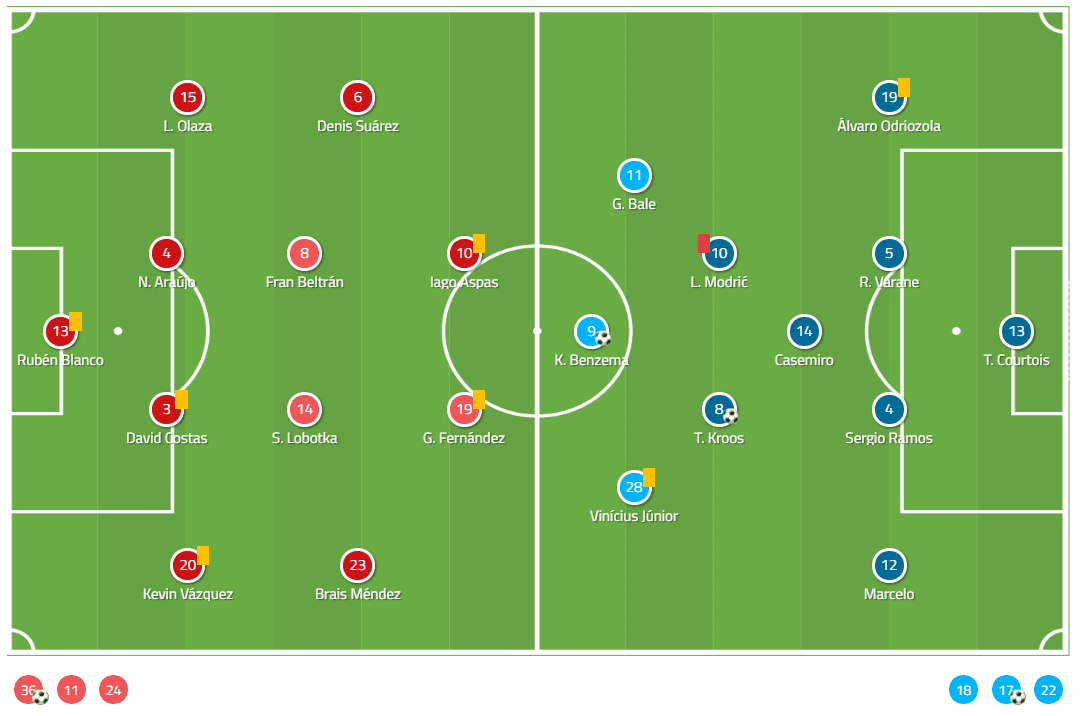
Escriba lined up with a team largely as expected, giving Toro Fernandez his debut up-front in place of Maxi Gomez, who has joined Valencia, whilst Denis Suarez was also given a debut, this time from a wide position.
Zidane named a side which was almost straight out of 2016. Only Vinicius Junior and Thibaut Courtois came into the team from the XI which was so established under the Frenchman in his last spell in charge. The tactics too remained the same in a 4-3-3 shape, with Gareth Bale earning a start on the right.
Diego Simeone style game management
It has become symbolic of Diego Simeone’s Atletico Madrid that after taking the lead, they will sit back into a deeper position and allow the opposition to dominate possession. With just 40.96% of possession, reaching as low as 33% in the 15 minutes after Benzema opened the scoring, it was clear that this was Zidane’s approach in Galicia. Almost immediately after Benzema opened the scoring, the team reverted to sitting deeper, shifting to a formation which was more akin to a 4-2-3-1 when in the defensive phase, rather than the 4-3-3 which had started the game.
Here, Modric and Casemiro formed a double pivot, sitting deeper, with Vinicius Junior and Bale sitting in a more protective position, with the two full-backs moving in to more narrow roles. This created a narrow back line which reduced the space for Fernandez and Iago Aspas to move into, also preventing runners from midfield with Casemiro and Modric tracking them closely. After an open start to the tie, this was crucial in establishing their foothold and control of the game.
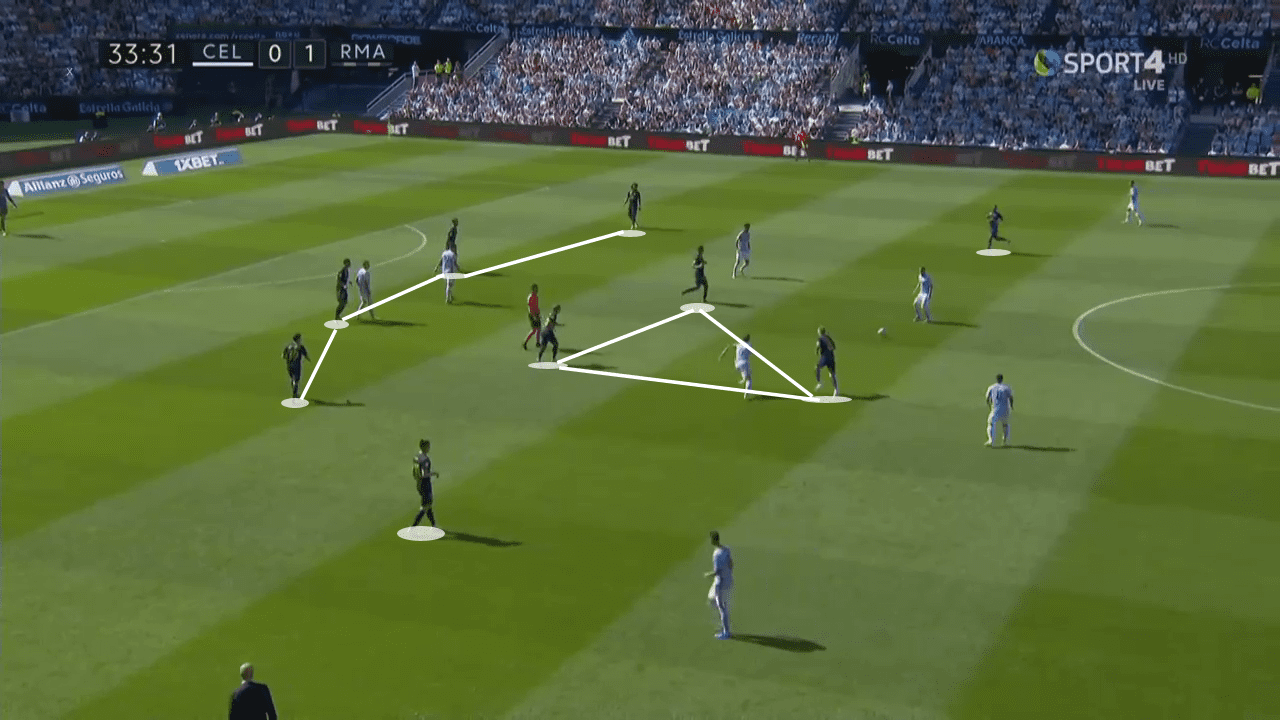
This was always the approach when out of possession, though Real Madrid did become more adventurous once again just before half-time. It was an approach which did not see Real Madrid dominate the ball, but they did have control over the pace of the game and allowed themselves more opportunities to get forward on the counter, capitalising on the naivety of Celta Vigo who got forward in numbers. That allowed greater space for Bale and Vinicius who could burst down the flanks with their pace, with Benzema keeping the two central defenders fully occupied at all times.
Left lop-sidedness
Though many of the post-match plaudits went to Bale for his fine display, having looked to be on his way out of the club for much of the summer, it is also important to recognise that the set-up of the team did him few favours. The team was heavily focused upon the left flank, where Vinicius started, for much of the tie, which led to the majority of their attacks coming down that wing. It also meant that the Brazilian had far more support from Marcelo on the overlap from the full-back position, to Benzema dropping into a deeper central role, his midfielders offering options and Sergio Ramos stepping up to bring the ball out.
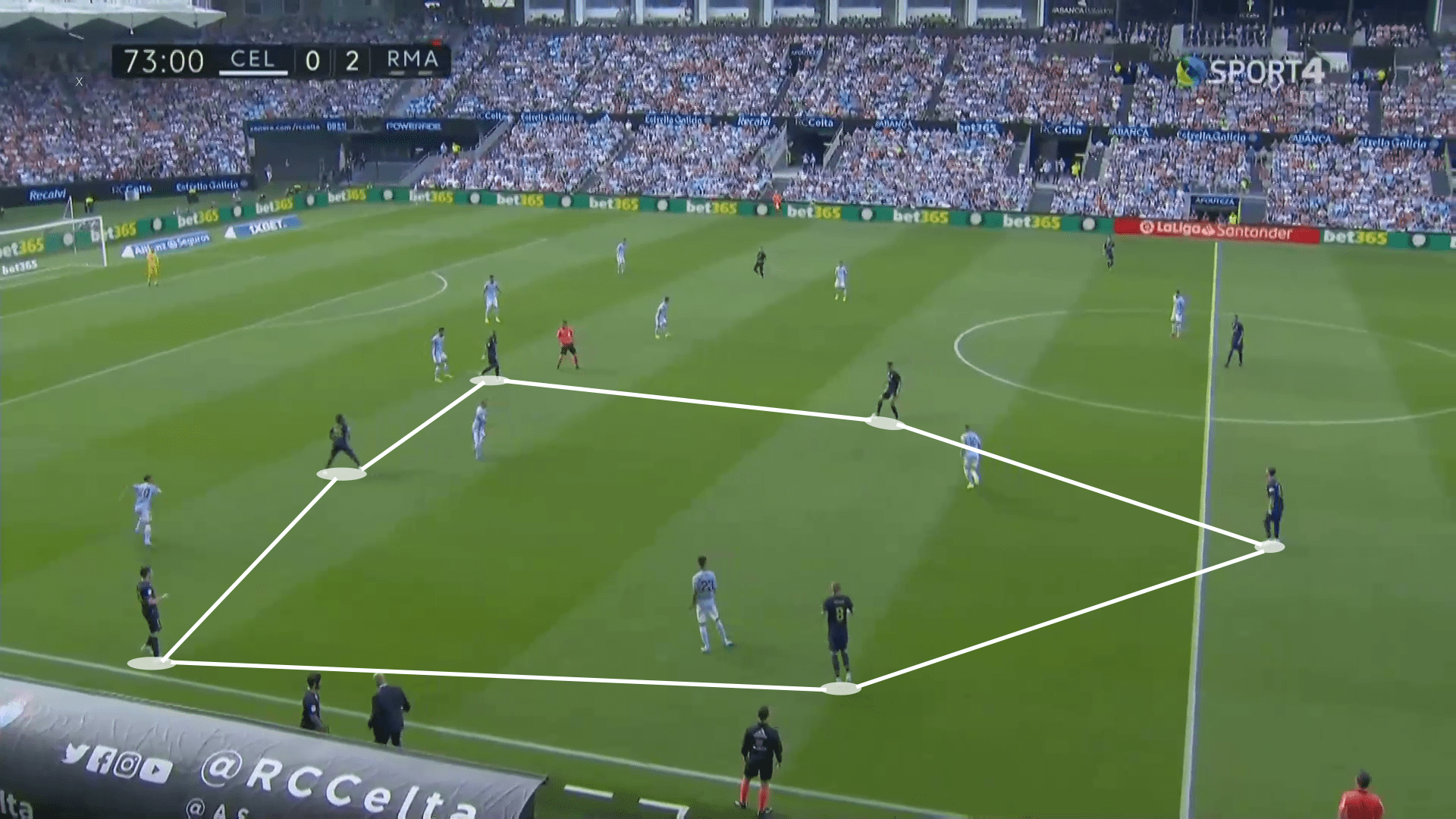
The above example reflects this, showing how Modric or Kroos would collect the ball in the middle with far more options on the left. Here, as many as six men are available on the left, leaving the right flank looking isolated and uninvolved. This invited Celta to overload their right hand side to counteract the threat and risked Real Madrid’s attack becoming excessively predictable. A quick change in direction could have reduced this, providing a threat exploiting the space on the right, but was rarely executed.
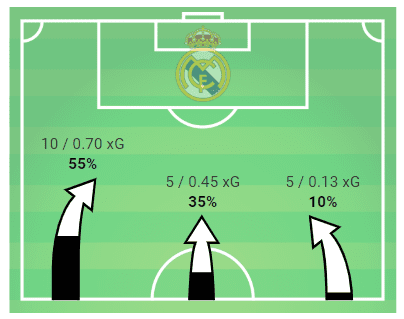
This meant that the majority of Real Madrid’s attacks and xG came down the left flank. That is not to criticise Bale’s contribution, but rather to show how the Welshman had more work to do to achieve any kind of result almost single-handedly down the right. Without that support from his midfielders, he was left to take men on with few other options. In total, Bale completed four dribbles, successful on every attempt. In contrast, Vinicius did not even attempt a single dribble, with the number of passing options available giving him the easy way out.
Gaining structure after the dismissal
Just before the hour mark, Modric was sent off for a straight red card offence, scraping his studs down the Achilles of Denis Suarez. Real Madrid were once again left looking to reestablish their control of the game, only now with one man down. The first change that Zidane looked to make to establish this was to bring on Vazquez in place of Vinicius, providing a more rounded solution who he knew would not be afraid to track back and contribute defensively. This was essential as the wingers effectively became wing-backs when not on the ball.
This was combined with Casemiro dropping in to become a third central defender, alongside Raphael Varane and Ramos. Unlike in the past, when he has acted like a sweeper, with the two central defenders tracking the forwards, he instead positioned himself slightly ahead so as not to leave Kroos isolated in the middle. This also allowed him to intercept play, with six of his eight interceptions all coming after the red card shown to his Croatian team-mate just shy of the hour mark.
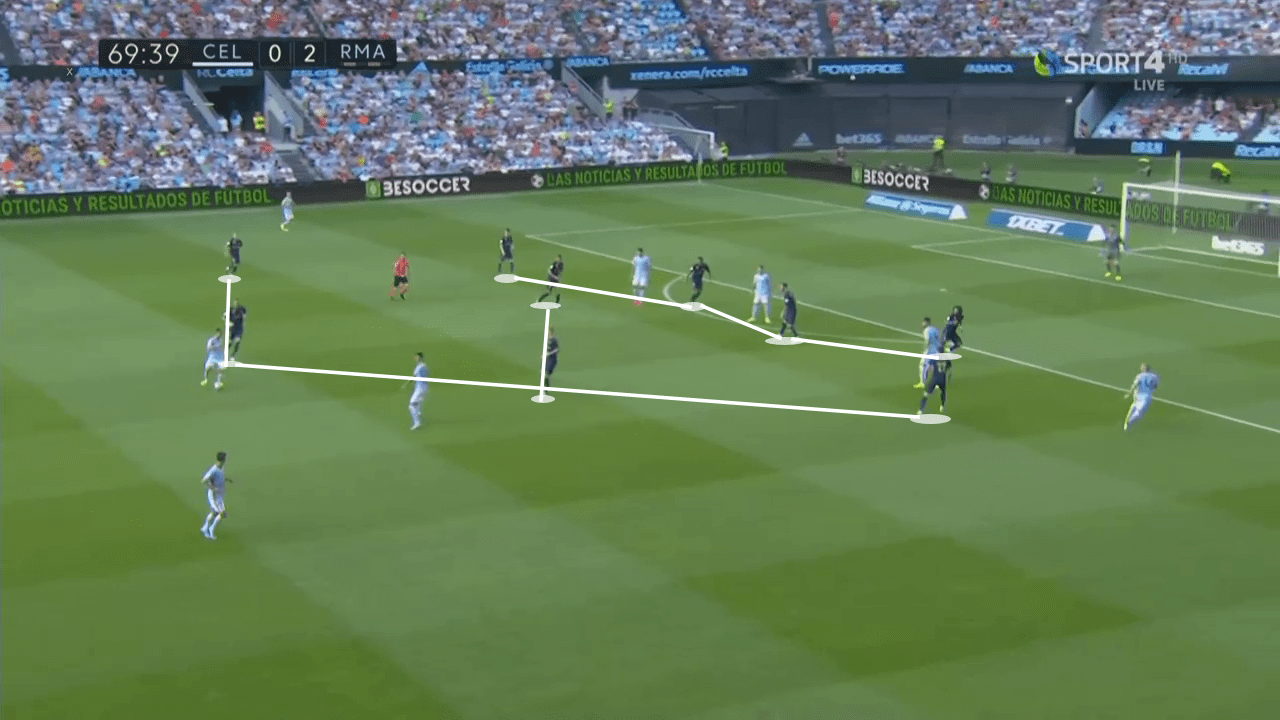
The defence remained more disciplined after this red card, allowing the two wingers to break forward with the freedom that Marcelo and Alvaro Odriozola typically would, while they remained more rigidly positioned. After Kroos’ long range effort gave a comfortable lead, again from a chance where the midfielder was not forced to push on too far, instead waiting to pounce and exploit space on the edge of the box. There was no need for any risks from Real Madrid and that was evident in Real Madrid’s set-up.
Still weak on the left on the counter
In spite of this, there were moments in where Real Madrid lost their discipline and showed glimpses of last season’s mistakes. Both full-backs, Odriozola and Marcelo, were guilty of advancing too far at times. In the very latter stages, with the arrogance that comes with a three goal lead and the tired legs of playing the first game of the season with 10 men for much of the second half, Real Madrid paid the price as Losada exploited the space left by the Brazilian left-back.
Throughout the tie, when Marcelo was caught out, his absence would be cancelled out by the positioning of Ramos, who would drift towards the left in order to provide cover, with Casemiro dropping in. In injury time, this was not the case as both full-backs had been pressing on, leaving Varane and Casemiro marking two men and engaging the runner with the ball. That left Ramos with a decision to make: drift central and look to cut out any pass to the right, or go with the runner on the right. His split second of hesitation left that gap open to allow Losada to get through with the pass being made before the captain had moved himself to either position so as to prevent the move.
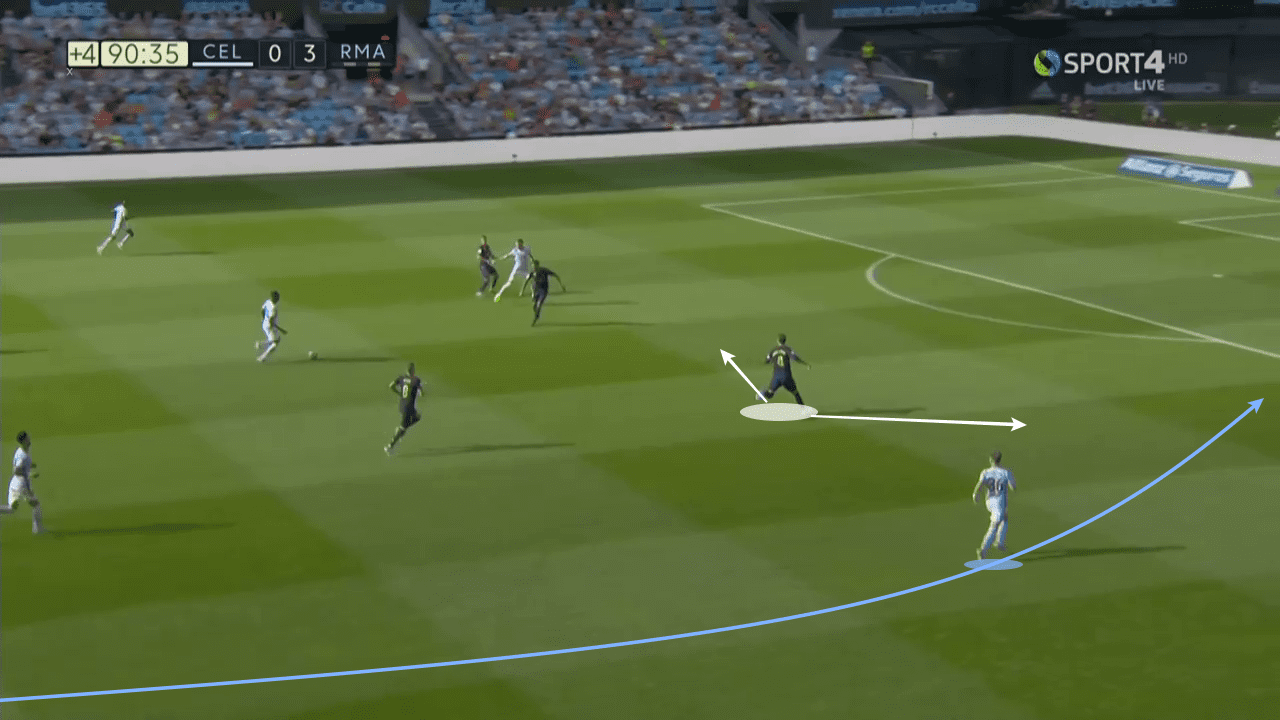
This was one of the team’s biggest weaknesses last season and through pre-season, and it seems that Zidane is still yet to find the solution. Ramos’ positioning for most of the tie helped to cancel out the threat, but questions should again be asked of why both full-backs felt the need to press so high with a three goal lead heading into injury time. Establishing such discipline, even when a goal against would be nothing more than a consolation, is essential for Zidane if he is to take Real Madrid back to the top.
Conclusion
This analysis shows that there are plenty of reasons for Real Madrid to be optimistic, looking to get back to basics without the need for glaring attacking flare, instead focusing on structured game management. However, there are signs that this approach may not last forever, particularly given the predictable nature of their attacking strategy and their defensive weakness with their overly attacking full-backs. Zidane can be pleased by the progress made by his players and their discipline for much of the tie when down to 10 men, but he should be looking to create a more equal distribution across the side in order to make a greater impact. With Bale performing well, it may be the best way to regain the trust and confidence of his team-mates to provide him with the support that he needs to make a difference. Topping La Liga from matchday one, Real Madrid will have a confidence boost which will set them up well for the rest of the campaign with a promising team and strategy which looks a huge improvement on their pre-season outings.

If you love tactical analysis, then you’ll love the digital magazines from totalfootballanalysis.com – a guaranteed 100+ pages of pure tactical analysis covering topics from the Premier League, Serie A, La Liga, Bundesliga and many, many more. Buy your copy of the August issue for just ₤4.99 here.

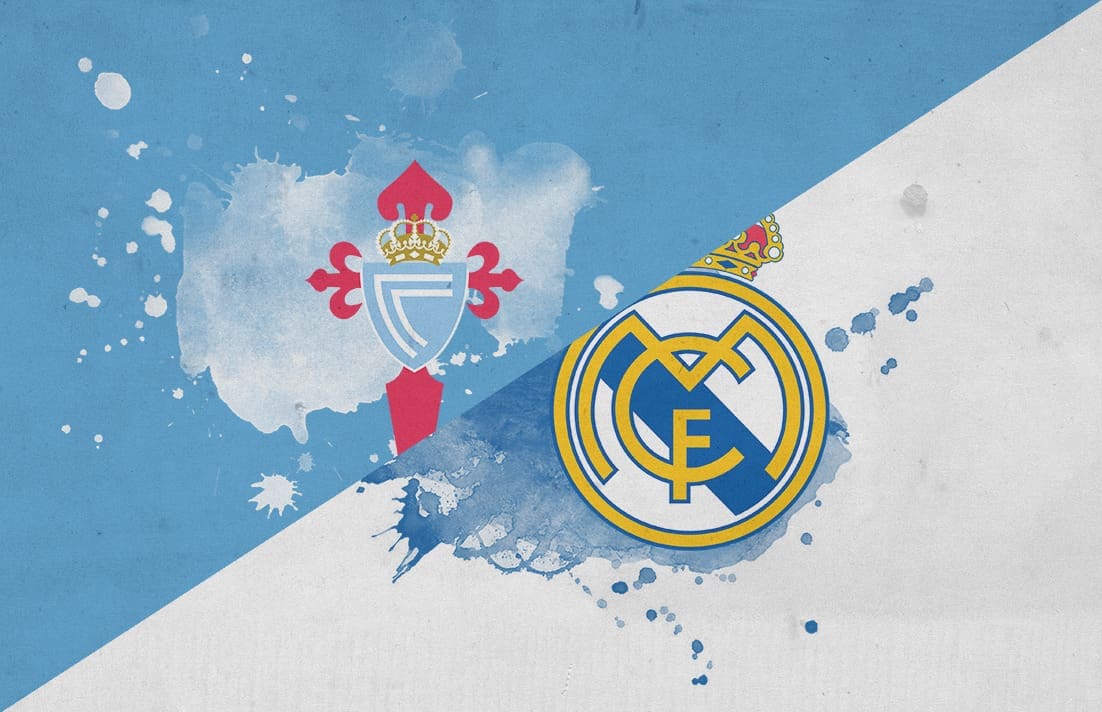



Comments